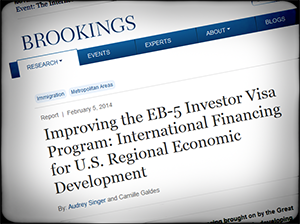This morning the Brooking Institution issued a bland assessment of the highly-controversial immigrant investor (EB-5) program.
The onward-and-upward title says it all: "Improving the EB-5 Investor Visa Program: International Financing for U.S. Regional Economic Development". EB-5 allows aliens with half a million dollars to invest in a government-approved, but not guaranteed, project and provide a set of green cards to the alien and his or her family in return.

There is no discussion in the report of whether this country should sell visas for half a million each (or for a higher figure) to aliens who usually have little else to offer this country.
Further, there is no dialogue about other, much better ways for such investments to be made in the U.S.; it is all about improving a seedy, inefficient, badly-run little government program, beloved by a few lightly-regulated American middlemen and nervous Chinese multi-millionaires.
Do you want the U.S. to get another half a million dollars (without selling a visa), and to have it happen quickly, openly, and without needless and expensive middlemen fees? Is there a way to do this?
There is. Take, for example, the rich person in, say, South Africa who decides that local gold mining stock is over-priced but that some American firm (Facebook or General Motors or whatever) is under-priced. He calls his broker, dumps the local stock and orders the purchase of the U.S. holdings and, in a minute or so, the deed is done – the money is flying into our economy – all at the cost of some modest brokerage fees, and no governmental involvement.
Brookings does not think such thoughts, and it plays down the way this program attracts a sometimes dubious mix of middlemen and failed developers. There is no mention, for instance, of the major EB-5 disasters in South Dakota that CIS has reported.
The Brookings report barely touches on other weaknesses of the EB-5 program, such as the minimal impact that it has on the routine, year-after-year net increase in foreign investment in the U.S. It does note that the increase in net foreign investment in 2012 (not a great year for that) was in excess of $200 billion, and that the EB-5 program had raised about $5 billion over the 20 years of its entire existence.
But it does not take the next logical step. Divide $5 billion by 20 years and you get an average of $.25 billion a year (though the average is rising); compare $.25 billion to $200 billion and you get 0.125% (one eighth of one percent). So, during that period out of every $100 in new net foreign investment, EB-5 was bringing in 12.5 cents!
the EB-5 Visa Program:
Currently the ratio is probably about one EB-5 dollar out of a hundred dollars in new foreign investments, and all at enormous costs is terms of inefficiencies, and presumably considerable losses to many aliens as well as the expenditure of precious visas. My sense is that a visa is a free good in the eyes of Brookings.
There is another anomaly that arises from the Brookings study. They record that there are more than 400 regional centers, the USCIS-certified middlemen who stand between the investing alien and the US business using the investments. Brookings notes that about two-thirds of the visas go to relatives of the investors within the 10,000 visa limit, perhaps to be reached this year. That means about 3,333 new investments.
What Brookings does not do is to divide the 3,333 by 400; the result is that each of the regional centers would have no more than an average of eight whole investments each year under current law. Of course some centers will get a lot more than that and prosper or at least break even, but there will be numerous failures in this over-population of regional centers.
But then Brookings and USCIS, generally, do not think in terms of over-population of any kind.
Brookings is not totally misty-eyed about the program, however, and makes some good comments about its administration, for instance:
- It points out that the agency lacks business expertise and suggests the U.S. Department of Commerce be enlisted to help run the program.
- It notes that "very little reliable, consistent and clear data exists that [would] make possible an evaluation of the ... program," notably in terms of job creation; Brookings is dead right on that point.
- It reports, in connection with the high percentage of family visas in the program, that "The explicit marketing of EB-5 visas as family visas is inconsistent with the classification of the visa as 'employment-based.'" EB-5 brokers in China apparently stress to parents that the EB-5 visas will do nice things for their children.
- It fails to note the second-class quality of virtually all EB-5 investments, which are sold more for the visas than for their financial strength, but it does say: "There are no estimates ... as [to] how many migrants see a return on their investments versus how many lose their initial outlay."
The last finding is an excellent one. In years of reading about EB-5 programs I have yet to see a report of an alien success story, such as the alien and his family got their green cards, and all their investment back.
Given that this is a 20-year-old program involving thousands of people, this must have happened, but I find it odd that the EB-5 community never mentions such an event. Perhaps it is rare.
Brookings cites no such claim along these lines, which makes it consistent with the rest of the EB-5 supporters.
